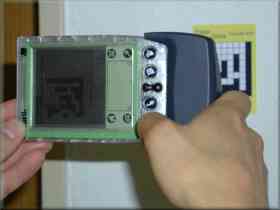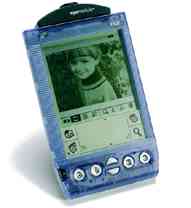|
Hyper
|
||
| Gloss | ||
|
||
Scenario
For every marker relevant information is displayed on the PDA. This information can be of different type, primarily text, in addition, pictures, videos or sound files. The information describes the "item" to which the marker is attached or gives other information of more indirect nature. After an appropriate selection e.g. the way to the next public toilet, to an inexpensive Italian restaurant or the best connection by means of public transportation will be displayed. The type of the represented information can be context sensitive: e.g. if the description of a way was requested, then the next acquired marker will be interpreted as a way point (�go now to the next traffic light ...�) whereas during in the �normal mode� the marker would perhaps display information about the historical meaning of the building the marker is attached to. There are different versions conceivable, how the information is stored. In a first - technically less demanding - version the information is stored on the PDA. The visitors of the city can borrow a PDA at the local tourist information or prior to their visit load the appropriate information from the Internet on to their own PDA. Apart from the official tourist information e.g. publishing houses (for a fee) or private individuals offer appropriate information. In a technically more complex version the PDA (or the UMTS mobile telephone) is connected directly with the Internet and timely information can be represented. In a further version the users of the system can add their own information to the system, e.g. the evaluation of a visited restaurant. The information is stored on their own web server and a marker (with the IP number of the web server and the number of the document; see figure 1) is printed and attached to the building. Ideas to remember
|
||


